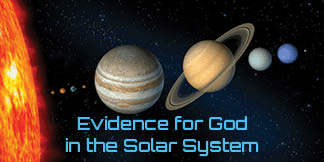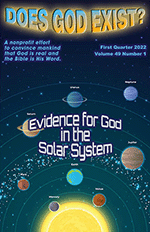Return to 1st Quarter 2022 articles.


We live in an exciting time in science. Scientists are making discoveries at an amazing rate, and there is no area where that is more true than our understanding of the Solar System. New telescopes, new space vehicles, and new ways of using radiation other than visible light have opened a door of greater knowledge than at any time in human history. As a result, our understanding of the Sun and planets is vastly greater than even a decade ago. When I read of the new insights and facts discovered in recent years, I am amazed.

What has escaped many people's notice is how this new information has provided more evidence for God's existence. We knew that some of our previous understandings worked, but we did not know why. Others worked, but only up to a point. An excellent example of this is “Bode's Law,” an early formula to predict the spacing between solar system planets. In 1772, Johann Elert Bode took Saturn, then the farthest known planet from the Sun, as a standard and gave it a value of 100. By that standard, Mercury would be four units out from the Sun. Then Venus would be 4 + 3 = 7. From that point, every planet's distance from the Sun would be four plus a doubling of the previous distance. The Earth would be 4 + 6 = 10. Mars would be 4 + 12 = 16. But Jupiter was 4 + 48 = 52, leaving a gap at 4 + 24 = 28. Astronomers thought they had resolved that problem when they discovered Ceres.
The law seemed to work for the currently known planets, and it worked for the discovery of Uranus. However, when astronomers discovered Neptune, it did not fit the formula. Then, they learned that Ceres was not a planet but a giant asteroid. Finally, when scientists discovered Pluto in 1930, it did not fit the formula. We now know that the distances result from the harmonic motions of these celestial bodies. The laws of celestial mechanics showed that the basis of Bode's Law was only a coincidence.

Our solar system studies have added many variables essential for life to exist on planet Earth. For example, we now know that our Sun is an extraordinary star. We know its size, its mass, the kind of radiation it emits, its stability, how far it is from Earth, and its chemical makeup. The more we look at other stars in our galaxy and other galaxies, the more we see the unique nature of our Sun.
Our studies of other planets in our solar system have shown us the importance of water in the liquid state and oxygen in the gaseous state. Water is present on many moons in the solar system and on a few planets. Still, planet Earth is in the “Goldilocks Zone,” where the temperatures are between zero and 100 degrees Celsius so that water can exist on the surface as a liquid, and life depends on that fact. Science disproves the claim that life could exist in some other ocean made of methane, nitrogen, or carbon dioxide. Redefining life so that there could be rock people or gas people based on some different chemistry is fantasy, but it is not science. The scientific definition of life requires being able to breathe, move, respond to outside stimuli, and reproduce. Rock people, gas people, etc., do not fit that definition.
We have learned the importance of magnetism to life on our planet. Earth has a liquid internal structure, allowing the movement of continents, the recycling of rocks, and the activity of volcanos. We realize that these essential processes apply only to a planet with an internal structure like ours. We have learned that Earth's rate of spin, the size and makeup of its atmosphere, the presence of radioactive elements in its crust, its support by the other planets in our solar system, and many other variables are critical to life. (You can see a chart of 47 variables that are essential to life on planet Earth on our website at https://www.doesgodexist.org/Charts/EvidenceForDesignInTheUniverse.html.)
The typical response of skeptics and atheists is that if you have enough time and enough planets, all of those things will eventually come together by chance. Unfortunately, people who make that claim have a poor understanding of statistics. Let us take a look at a very old atheist claim. If one million monkeys were typing on one million typewriters for one million years, one of them would type an encyclopedia totally by chance. Is that true?

Let us assume that the monkeys only have to type, “God,Jesus,Spirit.” That would be 16 characters, including the comas, no spaces. A typewriter keyboard has 58 keys so that would mean the number of attempts would be 58 x 58 x 58 x 58 x 58 x 58 x 58 x 58 x 58 x 58 x 58 x 58 x 58 x 58 x 58 x 58 or 16.4 trillion quadrillion attempts. Let us assume that the million monkeys are working without a break and typing the equivalent of 45 16-character words per minute. The average time for each word would be four seconds. How much time would elapse before we have a 50/50 chance that one monkey would finally, totally by chance, type “God,Jesus,Spirit”? The answer is 2,100 trillion years, which is 153,000 times the proposed age of the universe! This calculation is based on Bob Berman's article in Astronomy magazine (December 2021, https://www.astronomy.com/magazine/bob-berman/2021/12/chances-are), titled “Chances Are.” Berman concludes his calculations by saying, “Count me among the many who, when contemplating this astounding universe, perceive Nature as exhibiting some sort of underlying intelligence.”
In the last 25 years, we have found proof that the cosmos had a beginning. People who know scientific evidence can no longer question the statement of Genesis 1:1 that there was a beginning. We also understand that the complexity of the cosmos eliminates chance as a valid mechanism for what we see. The only debate possible now is what was the cause of the beginning? We would argue that there is enough evidence from other fields of human endeavor to say that cause was God. Saying that we cannot know or that somehow future knowledge will answer this question is an evasion. Proverbs 8:22-36 finds Wisdom describing its role in the creative process, and that wisdom belongs to God. The more we know of the creation, the more we know of the Creator.
Picture credits:
Cover: © artacet. Image from big stock.com
© Thufir. Image from big stock.com
https://commons.wikimedia.org/wiki/Category:Johann_Elert_Bode#/media/File:Johann_Elert_Bode.jpg
© Mihailo K. Image from big stock.com
© Tawng. Image from big stock.com
Scripture links/references are from BibleGateway.com. Unhighlighted scriptures can be looked up at their website.
